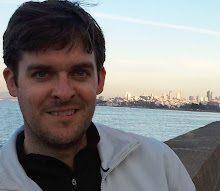As Aronofsky’s latest film opens over white titles on a black frame, a lone white spotlight illuminates an immobilized Nina Sayers (Natalie Portman) who is enshrouded in blackness on a borderless stage. The light continues to bathe her frozen pose which is not only symbolic of her solitude and her comfort level of being alone as she smiles at her state of desolation, but revealing of her status as a balletomane. She engages in a dance with the camera as it smoothly and fluidly follows her in a pas de deux. Moments later, their dance is disrupted by a dark figure approaching Nina from behind with headlong rage. With the camera changing partners and shooting over the other character’s shoulder in a hand-held method, this is not only emblematic of breaking the 180° rule, but representative of the crossover of elegant, cinematographic filmmaking techniques found in such films as Powell and Pressburger’s definitive ballet-fantasy, THE RED SHOES with those utilized in the New Hollywood. Such modern cinematic techniques include magnified sound effects (compliments of a talented Foley artist or a well-placed boom microphone) such as feet tapping the stage in ballet slippers and bones cracking as one’s toes curl. These standard actions (ambient sounds) are exaggerated and brought further to the foreground in modern cinema when in classical films they were either exhibited at the bare minimum or cut completely from the picture. There is a raw intensity to appreciate in Aronofsky’s vision of the modern ballet as he turns his camera to unexpected places like Nina’s pair of ballet slippers as she rips its stuffing from the sole like carcass off of a bone and its bottom is frenziedly slashed with a pair of scissors (no doubt to achieve comfortable footing on stage). In the film’s library of sound effects also exists variant sound cues of wildly flapping feathers which when fully and stunningly realized at the film’s climax, completes Nina’s transformation into a ‘Black Swan’ as black feathers cover most of her torso.
As witnessed in many of cinema’s dance-oriented films, a dance company’s success is dependent on group camaraderie, being on time to work and not sleeping with ‘the boss’ - - these manners are ignored in Aronofsky’s film. Additionally, the element of sabotage is thrown in for suspenseful effect as multiple characters vie to attain ‘the lead’ role. So ensues backstage politics which leads to backstabbing and character assassination on the modern stage. At a Gala party to celebrate the new dance season and Nina’s introduction as ‘The Swan Queen’ to a room full of arts patrons, a collection of New York’s upper crust and her fellow dance ensemble, Thomas whispers to Nina to brace herself as she is figuratively thrown to the wolves in her midst. She survives the evening without a scratch, however, she notices a small cut forming below her fingernail during Thomas’ endorsement speech praising her abilities. After the party, Thomas assures Nina that she did well which further alleviates any residual stress she feels for her understudy, Lily, whom she believes is trying to upstage her at every turn. Not only does Lily seem to have an uncanny resemblance to Nina, but also a penchant for disrupting Nina in practice (and a repetitive clumsiness that causes Lily to apologize to those around her) which bears heavily on Nina’s performance anxiety. With Thomas’ complimentary words, Nina officially becomes a detached outlier, not only dancing away from herself, but also outside of the sphere of the compatriots in her company. Uniquely, it is Nina’s self-sabotage that assists in strengthening her star power on the stage and at home with her overbearing ‘stage’ mother, Erica Sayers (Barbara Hershey) who repeatedly checks in with Nina via cell phone. A former ballet dancer herself before she focused on bringing up her daughter, Erica assures Nina that she’s “the most dedicated dancer in the company”. There is a moment that Erica continues to compliment Nina (calling her “sweet girl”) as she looks into a mirror over Nina’s shoulder when an unsettling graphic match reverse-shot is created - - as if Erica is horrified by something she sees in the mirror complemented by the simultaneous shriek of an underground subway train moving hurriedly on a track with the reverse shot match of Nina looking at her reflection in the soiled window of the subway car. It is as if Erica witnessed something disturbing in her daughter that only Nina could see through the power of reflection.
Mirrors and reflections (as well as Lily’s duplicity) featured throughout the film prey on Nina’s paranoia of her abilities being overshadowed and eventually produce hallucinatory visions of a darker double with a pair of rubied, bloodshot eyes which are later followed by the appearance of barb-like feathers puncturing through her wound. A doppelgänger’s lair rests within the cold confines of the mirror which populates the entirety of BLACK SWAN and Pandora’s Box is unleashed through Nina’s continued scratching at its/her skin’s surface. When Thomas revealed to his company that they would be performing “Swan Lake’, Aronofsky seems to speak through him of his own film, "done to death [Nina’s performance literally ends with a poetic death], I know, but not like this. We strip it down, make it visceral, but real.” He asks of his company which of them is able to embody the white swan; as he inquires as to whom will be able to portray the black swan, his question is posed to his dancers directly in the reflection of the mirrors surrounding them. Nina also uses the reflective device as a tool to achieve absolute perfection through her own death at the finale of the performance. Taking a leap of faith from high atop the set piece of a cliff in the self-reflexive production-within-a-film, Nina lands safely on a mattress, but is found to have previously stabbed herself with a shard of glass from her dressing room mirror. Bookending the film in mirror-like symmetry with how it opened, Nina is again immobilized as she smiles at her “perfect” one-night-only performance while drowning in an intense white light. In Aronofsky fashion (a contemporary tragedian), no one will arrive in time to resuscitate her. Nina has exhausted her humanly value and will “lose herself”, as per her director’s (Leroy/Aronofsky) wishes. And by the film’s completion, it is the White Swan who overpowers the Black Swan as Nina finds comfort in her demise as black titles on white close the film and whiteness bleeds into the edges of the frame.







